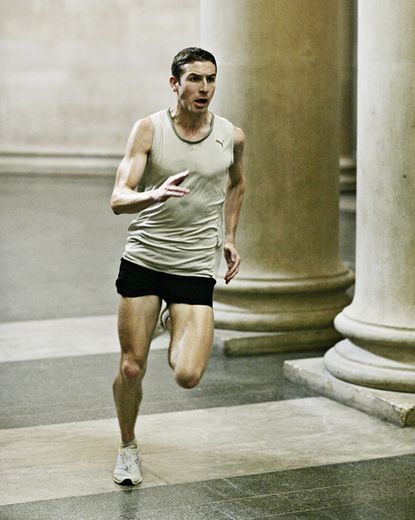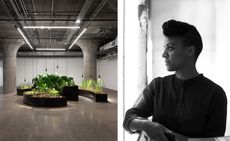Martin Creed Work No. 850

Like picnics, loud music and dogs, running isn’t usually allowed in an art gallery. But anyone paying a visit to London’s Tate Britain might want to look left and right before crossing an empty space. For 2008’s Duveen commission, Scottish artist Martin Creed has created an installation whereby a lone runner charges the 80-metre length of the gallery at full pelt, every thirty seconds.
The extraordinary piece is in many ways typical of Creed’s continued exploration to find the most succinct expression of a human action or experience. For the viewer, standing on the imaginary sidelines of the neoclassical Duveen galleries, the piece is at once amusing and a little disturbing.
On face value, the work is poetic in its rhythmic regularity. Just as one runner disappears, so there’s a small pause to breathe and another starts up. Musing on what they might represent, one can’t help thinking existential thoughts. Perhaps this is due to the sheer human physicality on display but also because the rhythm reminds one of the relentless sometimes disturbing, sometimes reassuring ebb and flow of life.
We caught up with the artist and Jochen Zeitz, CEO of Puma who provided the shoes and apparel for the runners, to hear more about the project…
How long has the project been in the offing?
Martin Creed: Well it's been years that I've been trying to make a piece with runners.
Your inspiration came from having just five minutes to see the catacombs?
Wallpaper* Newsletter
Receive our daily digest of inspiration, escapism and design stories from around the world direct to your inbox
MC: Indeed. I thought after that experience maybe it's good to see things quickly. It can be very laborious trudging through a museum. It can feel like hard work and I don’t see why it should be. You should feel free to look at things for a second, a minute or an hour.
Do you feel it's about people viewing the runners or about the experience the runners themselves have?
MC: That's one of the things I started thinking about only when we began to put the project together. I think it's beautiful watching people running. Hence initially I wanted to make a work that simply shows people running and take it from there.
Do you feel that putting runners in an unexpected context like the gallery gives the exercise an unusual perspective and maybe a sense of intrigue?
MC: Yes but for me I'm making something for people to look at. A gallery is a theatre for displaying things for people to look at.
But it has a slightly irreverent connotation too doesn't it?
MC: Well not to me, it doesn't really.
Surely if a normal visitor just started running down a gallery at full speed they'd probably be stopped pretty quickly?
MC: You’re right. There's usually no running allowed in a gallery, because it's dangerous.
Watching reactions many people seem to find it amusing. Is this intentional?
MC: Seeing people run makes me smile. I think running is a good-natured thing. It's very difficult to run if you've got a bad attitude. I've learnt finding the runners for this project that the ones with a bad attitude can't do it because they can't run fast enough. You can't fake running. You either run properly or you're not running. In this sense it's quite a true human action.
Are they running to anywhere?
MC: To the end of the gallery. Well the runners are all alone, just like us, making their way.
How many are there in total?
MC: Well there's only ever one at a time running through the gallery. But there are teams of four to six people looping around to provide a constant stream every thirty seconds.
What’s the significance of the thirty second break?
MC: It's very important. I want it to loop. I'm putting something on that I want to be easy for people to see. Just like a painting, I want it to be very frequent so that people can rely on it being there. So the thirty-second rhythm is designed as a constant. There's a little bit of breathing space and then it's there. Think of walking on the beach and the waves coming in, it's endlessly happening so you can reliably enjoy it. Most exciting fast events aren't reliable. If a shoplifter runs away from the police, it happens suddenly, just once and you can’t see it again.
How did you select the runners?
MC: They were chosen based on aptitude and attitude. They need a combination of speed and stamina to last the four-hour shifts they do.
Have you spoken to them about the project?
MC: Yes a lot but the job is very simple. They just need to run through the gallery as fast as they can, repeatedly. Having said this it's very hard work, which is one of the reasons why they need good shoes.
Were Puma involved in the selection of runners?
Jochen Zeitz: We were very happy that our product met Martin's approval for the project but we didn't get involved in the artist's selection of athletes. We are happy that the Puma brand is a progressive brand that fits the concept of this work. We're also thrilled there's a variety of cultural backgrounds, ethnicities, men and women runners - this is what Puma is about.
This involvement in art and design is an important part of the Puma heritage isn't?
JZ: Yes it is. We're a brand that constantly tries to push traditional boundaries and experiment with art and design primarily. They both play a very important part in what we do and having this opportunity to bring together sport with art is truly pushing the boundaries, opening up new horizons for us also as a brand as well as for the people using the product. It lends the product a new angle as part of a performance still, but it's artistic as well as athletic, in a gallery, which fascinates me when I watch it. The contrast is very exciting.
MC: This is why the regularity of timing is so important to me because you need something to be a constant so the differences in speed, height, character of the runners becomes more apparent. I really like the differences between all the runners.
There are rumours you're collaborating again later this year too, is that right?
MC: We've been talking about lots of things but who knows what's going to happen. For me I don’t think of design and fine art being very different. Just as I don’t think of sport and art being very different. All I try to do is put together different colours and shapes and this is what designers do. If you think of sport as using your body to maximum effect - this is all I do in my life, whether I'm making a painting or a phone call, I'm using my body to move around. All people do is move around and make noises. So to me there isn’t really any difference - it's a matter of doing whatever you do to the maximum effect.
JZ: Yes but to a lot of people these boundaries still exist and producing a work like this helps to dissolve them. A few decades ago we dissolved the boundaries between sport and design, realising the two had to go hand in hand. The product needs to perform but it also needs to be aesthetically pleasing and attractive. It doesn't sound groundbreaking now but it was really revolutionary at the time for us to say this and to talk about lifestyle in the same sentence as sport. Now this is pushing it further again and the general public are having their horizons broadened further still with this work of art.
MC: Artists also are people who make commodities they hope people will buy. My work is a commodity, I might just make one of these pieces where Puma might make millions but it's still a product and I want my work to be used by people. I think of my work as succeeding if it gets used, be it to entertain or to make people think about something. This is still a use. This is the way I think about what I do. I'm trying to make things that work and are functional in what they are.
It's Puma's 60th anniversary this year - happy birthday - how has the brand changed over 60 years?
JZ: Well it started as a purely functional non-stylish performance brand, delivering footwear (apparel and accessories came at a later stage). It was only for functionality, not for design and looks. In the 1980s the son of the founder said that products have to function, they don’t have to look good so long as they function. Here we are 28 year's later and how much the world has changed, we are a sports lifestyle brand that mixes influences of sport together with lifestyle and fashion. We're constantly on the move to show why our products still work to an optimum but they look good too.
And what does the future hold?
JZ: Let's talk about the future when the future comes. This is just a really wonderful way to explore new territories as a brand, because art provides a new dimension that we don’t get exposed to on a daily basis. So it's provided an unusual laboratory for us too to see our product in a new context. It's inspiration for us to push forward and see our own future in new ways.
ADDRESS
Tate Britain
Duveen Galleries
Millbank
London SW1P 4RG
-
 Kapwani Kiwanga considers value and commerce for the Canada Pavilion at the Venice Biennale 2024
Kapwani Kiwanga considers value and commerce for the Canada Pavilion at the Venice Biennale 2024Kapwani Kiwanga draws on her experiences in materiality for the Canada Pavilion at the 60th Venice Biennale
By Hannah Silver Published
-
 Marcio Kogan’s Studio MK27 celebrated in this new monograph from Rizzoli
Marcio Kogan’s Studio MK27 celebrated in this new monograph from Rizzoli‘The Architecture of Studio MK27. Lights, camera, action’ is a richly illustrated journey through the evolution of this famed Brazilian architecture studio
By Jonathan Bell Published
-
 Minotti presents Giampiero Tagliaferri’s Supermoon sofa at Salone Del Mobile 2024
Minotti presents Giampiero Tagliaferri’s Supermoon sofa at Salone Del Mobile 2024Minotti brings its new Supermoon collection to Salone del Mobile 2024, with a unique blend of Milanese and Californian aesthetics
By Jasper Spires Published